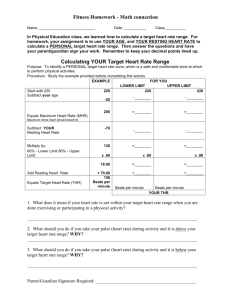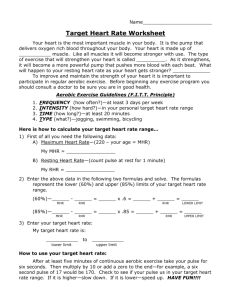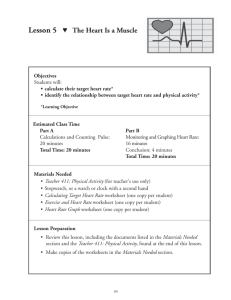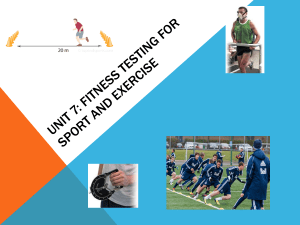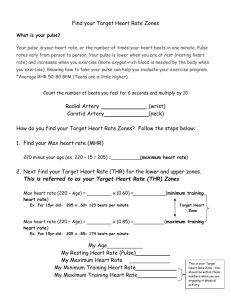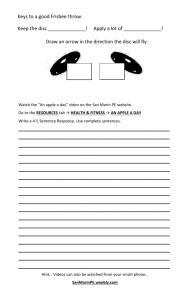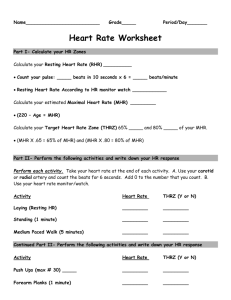Cardiorespiratory System
advertisement
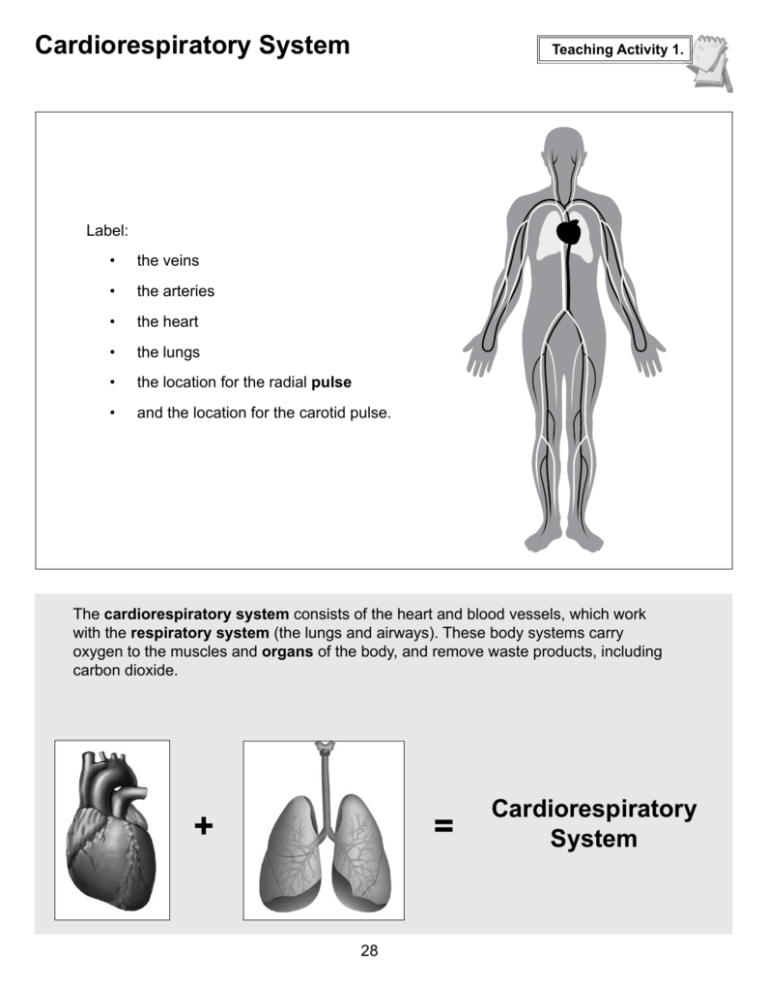
Cardiorespiratory System Teaching Activity 1. Label: • the veins • the arteries • the heart • the lungs • the location for the radial pulse • and the location for the carotid pulse. The cardiorespiratory system consists of the heart and blood vessels, which work with the respiratory system (the lungs and airways). These body systems carry oxygen to the muscles and organs of the body, and remove waste products, including carbon dioxide. + = 28 Cardiorespiratory System The Most Important Muscle: The Heart Teaching Activity 1, continued. In the circulatory system, the heart is a muscle that acts as a pump. In fact, the heart is a double pump. Blood that needs oxygen enters the heart and is pumped by the first pump to the lungs. The second pump of the heart pumps the oxygen-rich blood to all the other parts of the body. This gives the heart its common, “lub-dub” sound. The number of times the heart pumps, or beats, is counted in a minute. This is known as the pulse rate. A person’s pulse is affected by their current level of activity. If you are sleeping or do no physical activity at all, your heart is pumping at a resting heart rate. When active, you are using all your body systems. These systems require fuel in the form of calories (found in food), and oxygen (what you breathe). The more active you are, the more fuel your muscles need. This is why your breathing rate and your heart rate increase when you exercise. Knowing how to take your own heart rate can help you exercise properly and safely. You can take your own heart rate by finding two major blood vessels, or arteries, on your body: • Radial: This artery is located on the inside of the wrist near the side of your thumb. • Carotid: This artery is found on the neck between the windpipe and neck muscle, and just under the lower jawbone. Once you “feel” your pulse, use both your index finger and middle finger. Count the pulses, or beats, for 10 seconds. Aerobic capacity is the highest amount of oxygen used during vigorous exercise in activities that use the large muscle groups. Hearty Facts • Your system of blood vessels (arteries, veins, and capillaries) is over 60,000 miles long. That’s long enough to go around the world more than two times! • The adult heart pumps about 5 quarts of blood each minute, approximately 2,000 gallons of blood each day, throughout the body. • The heart beats about 100,000 times each day. • In a 70–year lifetime, the average human heart beats more than 2.5 billion times. • A child’s heart is about the size of a clenched fist; an adult’s heart is about the size of two fists. • Blood is about 78 percent water. • Blood takes about 20 seconds to circulate throughout the entire vascular system. 29 Teaching Activity 1, continued. Today’s classroom activity will help you learn more about heart rate. 1. This first activity requires some simple math to find your maximum heart rate (MHR), which is the highest number of heartbeats in a minute for a person your age. Simply subtract your age from 220: 220 – _____ (age) = _____ your MHR in one minute. For the remaining activities, you will need a partner and a watch or clock with a second hand. 2. The resting pulse is the number of times your heart will beat in one minute after resting for at least five minutes. Find either your radial or carotid pulse. Once you “feel” your pulse, have your partner “start”, and then “stop” counting after 10 seconds. Record your resting heart rate (RHR): 10 second count = _____ x 6 = ______ RHR for one minute. 3. Do the following activities and record your pulse for 10 seconds: Walk for 30 seconds Heart rate: Jog for 30 seconds Heart rate: Run for 30 seconds Heart rate: Sprint for 30 seconds Heart rate: Do jumping jacks for 30 seconds Heart rate: Other: Heart rate: The target heart rate (THR) is the range in which you want your heart beating to develop cardiorespiratory endurance. To develop good cardiorespiratory endurance and become fit, you need to be in your target heart rate for at least 20 minutes without stopping. This is one of the best ways to increase your aerobic capacity, or the highest amount of oxygen used during vigorous exercise in activities that use the large muscle groups. You can find your target heart rate by using simple math. Multiply 0.7 (70%) by your MHR (from #1): 0.7 x _____ your MHR = _____ THR. 4. Take your THR and divide by 6: THR / 6 = _____ for a 10-second count. Look at the heart rates you recorded for activity #3. Did you reach your THR using the 10 second count? Circle the activities where you were in your THR, and repeat for up to 10 minutes. 5. Why does your heart rate increase when you are physically active? ______________________________________________________________________________ Teachers: Have students volunteer other activities that would increase their heart rates such as playing tag or doing jump rope. 30
